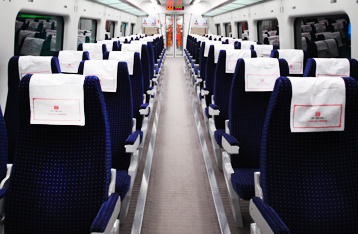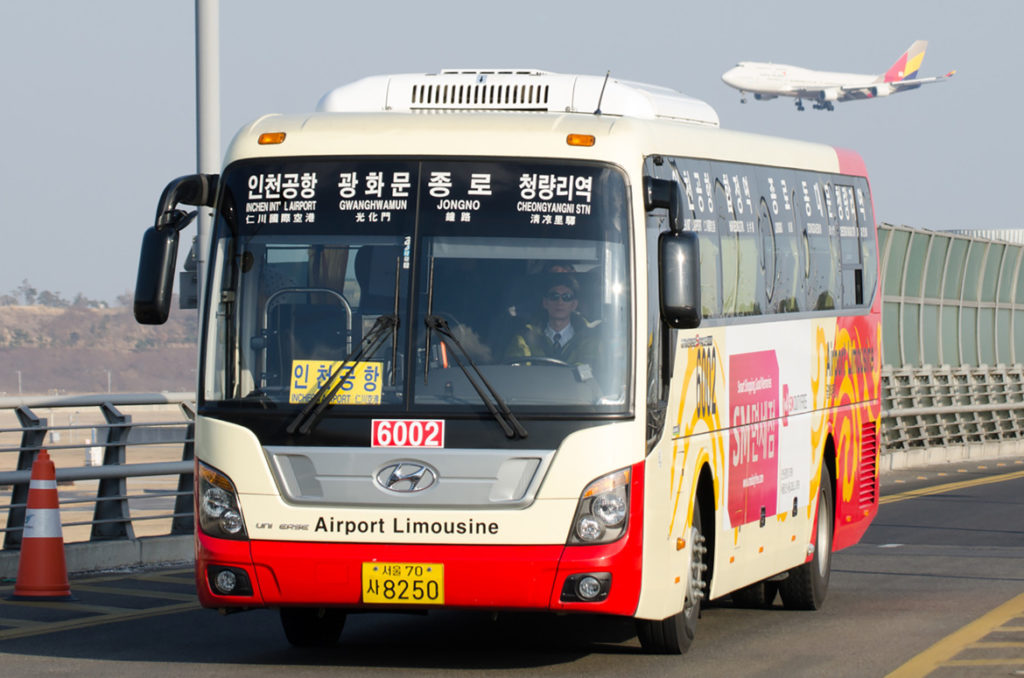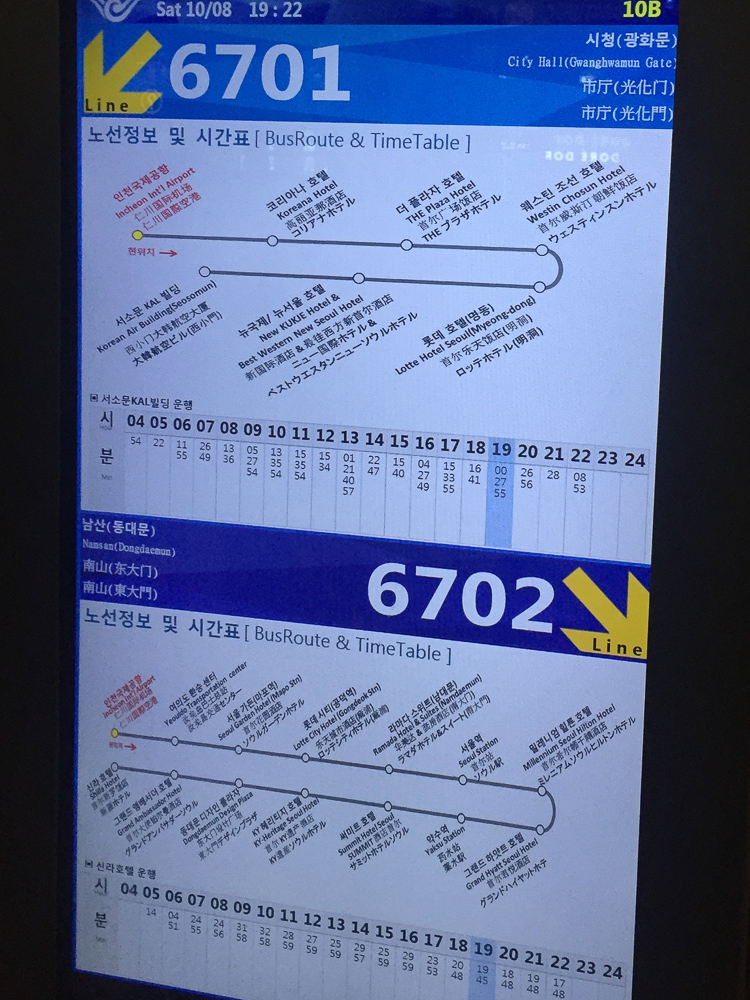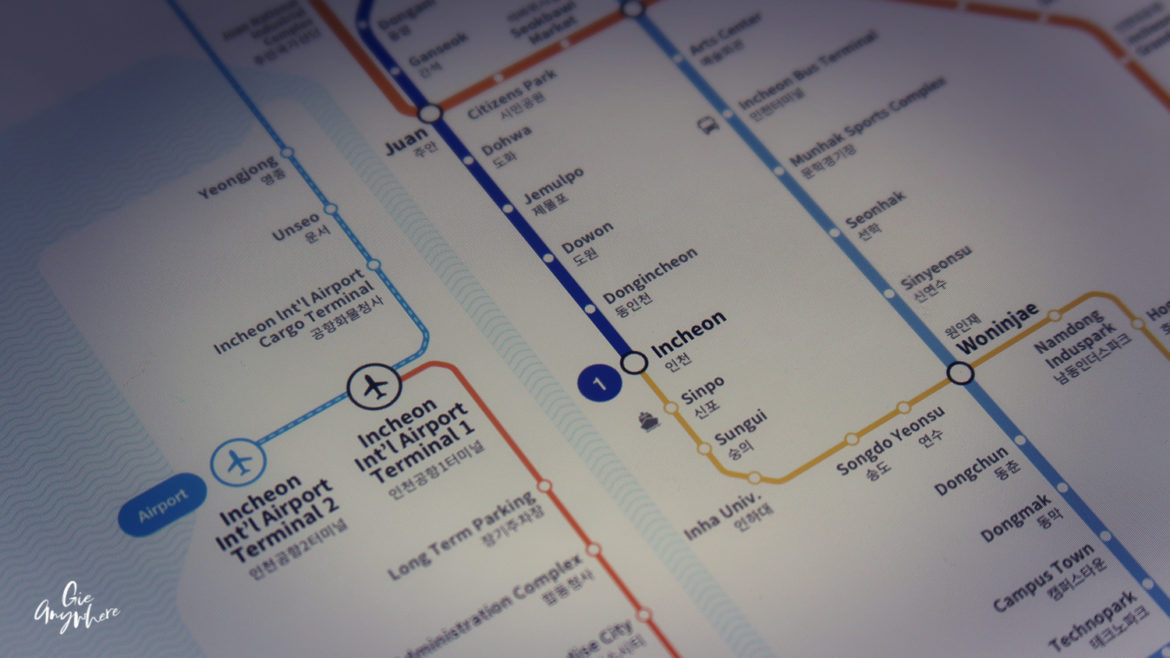There are 2 international airports near Seoul: (1) Incheon International Airport (ICN), and (2) Gimpo International Airport (GMP). Although it’s an international airport, Gimpo airport is only for short-haul flights and is mainly used as a domestic hub.
If you’re flying into Seoul, chances are, you’ll be landing at Incheon International Airport. Incheon is actually another city, about an hour away from Seoul.
Airport Transfers: 3 main ways to get from Incheon International Airport to Seoul
1. Train / Airport Railroad
If you’re planning to take the train, then you’ll be riding the AREX (short for “Airport Railroad Express”) to Seoul Station, which is the main train hub in Seoul.

You have 2 options: the regular “all stop train” and the premium “express train”, with the latter costing twice as much as the former. The image above will give you an overview of the difference between the two. If the hotel you’re staying in Seoul is near a subway station, then taking the train is a good option.
All Stop Train
Fare: ₩ 4,150
How to purchase: Use prepaid transport card (i.e, T-Money, Rail+, Cashbee)

This is a regular commuter train that stops at all stations between Incheon International Airport and Seoul Station. Going from ICN Terminal 1 to Seoul Stations takes about 1 hour. You have no guaranteed seats and the luggage racks are limited. Basically, it’s the same train as the ones you ride when you take the subway.
If Seoul station is not your final stop and you need transfer to another line, you just add about ₩100 to your fare. In my case, I booked an Airbnb near Hyehwa station (Line 4) and I was charged ₩4,250 on my Rail+ card.
> Buy your Rail+ card online and save $$!
Just pick it up when you arrive at the airport. I bought mine at the AREX information booth for ₩ 4,000. I could’ve gotten it cheaper if I bought it online beforehand. Oh well..
The ‘all stop train’ is the cheapest of all the transport options from Incheon International Airport to Seoul! Perfect for solo travelers and digital nomads
I recommend this route only if you don’t have heavy luggage and you’re prepared to walk and carry your luggage around. Although the subway stations have lifts/elevators, you may sometimes have to carry your luggage going up and down the stairs.
Express Train
Fare: ₩ 9,000
How to purchase: You can buy it at the AREX Express Information Centre (at the basement of Incheon International Transport Center) or you can buy it online here (which works out cheaper too!)

Inside the AREX Express train. Credits: www.arex.or.kr
A premium train service, the Express Train goes from ICN airport straight non-stop to Seoul Station in just 43 minutes. It’s roughly 15 minutes faster than the all stop train so if you’re short on time or you just want to arrive faster, then the express train is your best option.
Since seats are pre-assigned, you know there’s a guaranteed seat for you, unlike the all stop train where it’s on a first-come, first-served basis. The seats are more comfortable, with lots of room for luggage.
TIP: If you’re planning to take the AREX Express Train, I recommend you buy a voucher online from Klook, as it is much cheaper than buying it on the spot. Be aware that you still need to redeem the actual physical ticket at the Information Centre; you just need to show your voucher code.
2. Bus

Incheon Airport Limousine Bus. Image Credit: Go’s Blog
Fare: from ₩10,000 to ₩16,000 (depending on the type of bus and your destination)
How to purchase: Bus ticket counters (inside the Arrivals Hall Floor 1 or just right outside the exits), or prebook a KAL limousine bus ticket online.
For more convenient transfers, there’s the airport limousine bus. This is a better option for you if you have heavy luggage or more than 1 bag. Travel time takes about 45 mins. to 1 hour, making it about the same as the regular train.
Some bus routes also stop at selected hotels in Seoul, making it an easier option compared to taking the train. Take a look at the legit hotel bus stops below:

Hotels in Seoul which are legit bus stops. Credit: Travel Update
There are 2 types of airport buses: (1) the deluxe and KAL (Korean Air Lines) buses, which has stops at major hotels in Seoul, and (2) standard buses. The deluxe and KAL buses are more comfortable and spacious, but are more expensive. The standard buses, on the other hand, are cheaper but they have more stops.
For information on airport limousine bus routes, bus stop and schedule, click here to visit the official site. If you want to plan your itinerary and search for bus routes, check fares, and interval time between buses, click here to visit the airport website.
You can find bus ticket vending machine kiosks at the exit, manned by staff to assist passengers. There’s also the option to pay cash to the driver or use your T-Money card. But if it’s your first time in South Korea (or first time to ride the airport bus), it’s best to buy the ticket at the counter. This is to make sure you’re paying the right fare, to the correct destination and getting on the right bus.
For more info on how to use the airport limousine bus, this blog has a helpful step by step guide.
This is also good for those whose final stop in Seoul requires several train line transfers and walking (but don’t want to pay a lot for taxi). However, if you’re traveling in a big group (5+ people), or traveling with young kids or senior citizens, getting a taxi or a private van transfer would be a much better option for you.
3. Taxi / Private transfers
Taxis can be categorized into 2 types: metered taxis and international taxis. The main difference between the two is that international taxis charge a flat rate, depending on the zone classification of your destination. The metered taxis are classified into 3: regular, deluxe and jumbo (which can accommodate 6-10 people).
The base fare for a regular taxi is ₩3,000 (which is standard for Seoul), which increases 20% during nighttime from midnight till 4am. The base fare for deluxe and jumbo taxis is ₩5,000 but there’s no additional nighttime charge.
To make sure that there is no language barrier and so you won’t have any hidden surprises, I highly recommend you book your airport transfers online in advance.
Private car transfer starts at $55 for 1-2 people, $61 for 3-5 people, and $78 for 6-7 people. If you’re traveling with a bigger group, that can also be arranged.
If you’re planning on taking the international taxi, Jan from Janiscooking.net wrote about his experience and came up with a really helpful guide.
Hope you find this guide helpful! 
How about you? Have you been to Seoul before?
What is your preferred mode of transport? Train, bus or taxi?
Let me know in the comments below!

